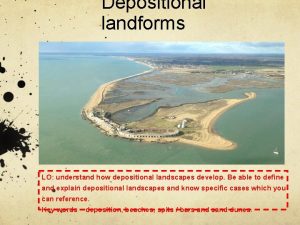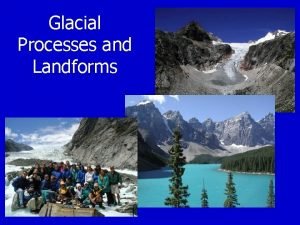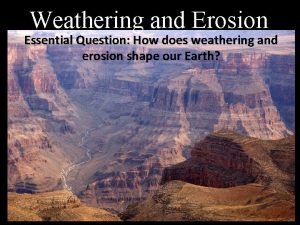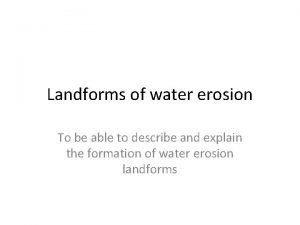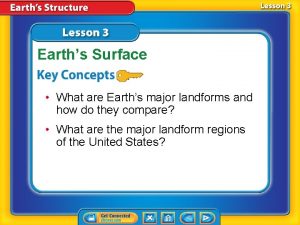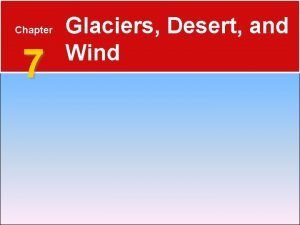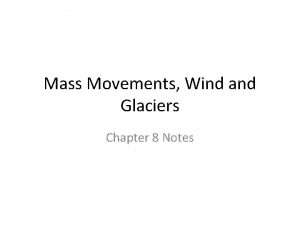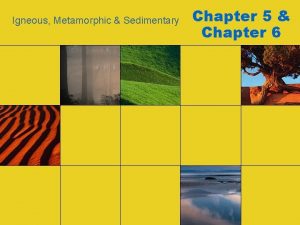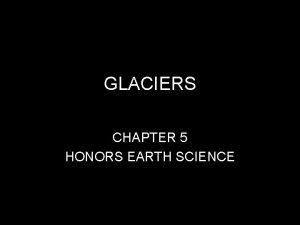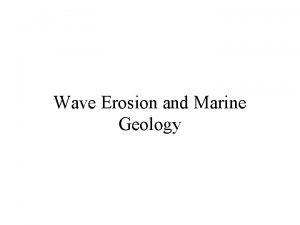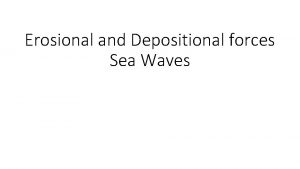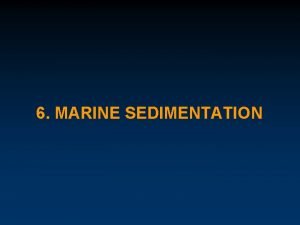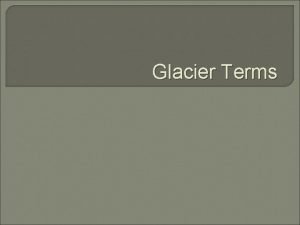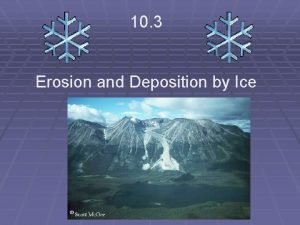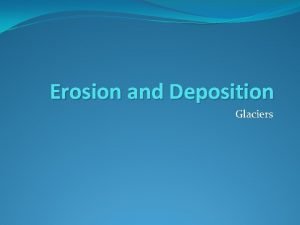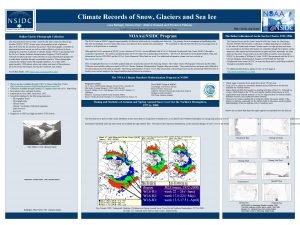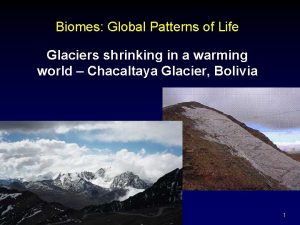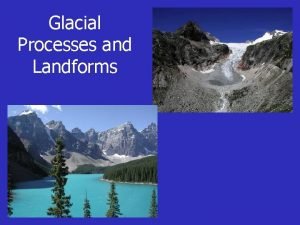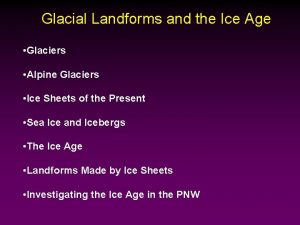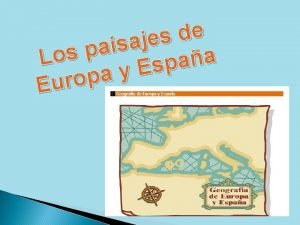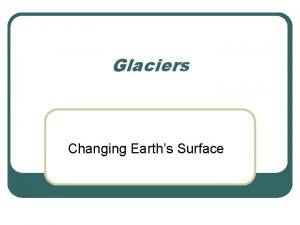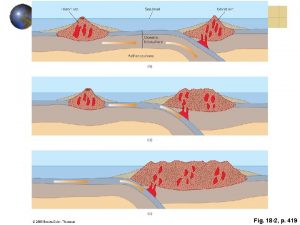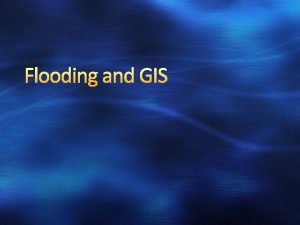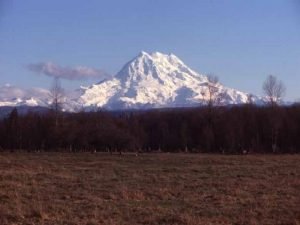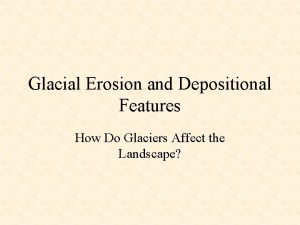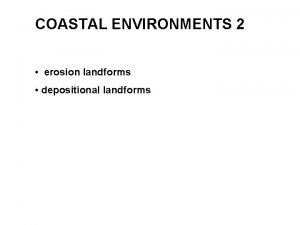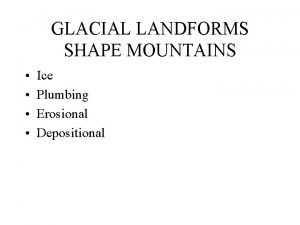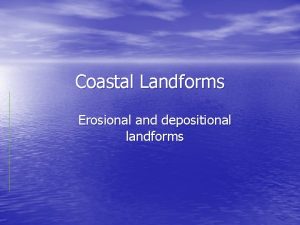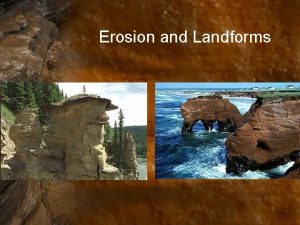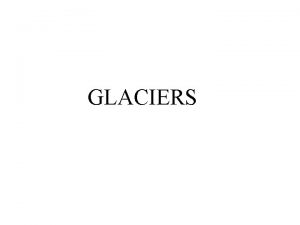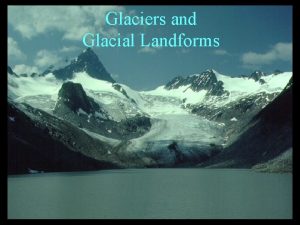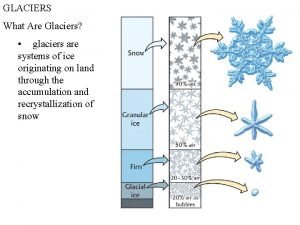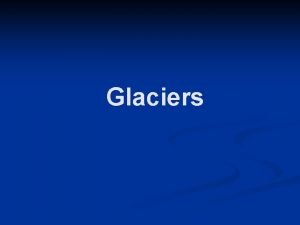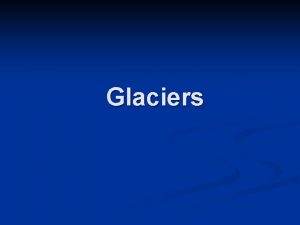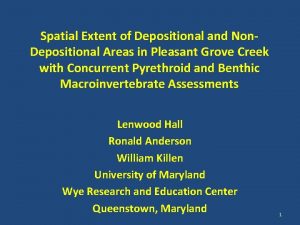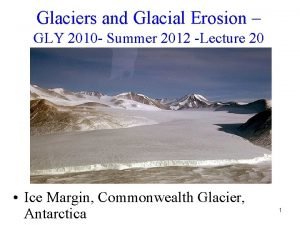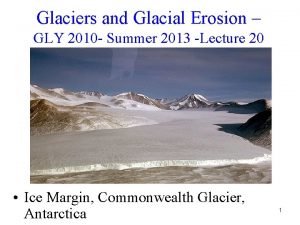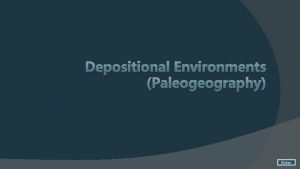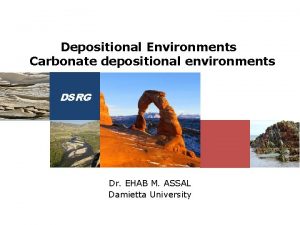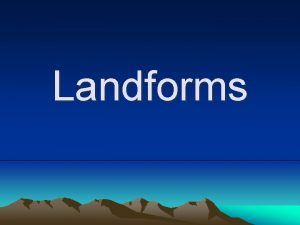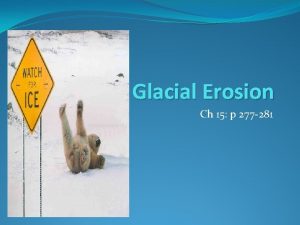Glacial Erosion and Depositional Landforms Erosion Glaciers are





























- Slides: 29

Glacial Erosion and Depositional Landforms

Erosion ● Glaciers are powerful shapers of the landscape ● They erode through two key processes: ■ Plucking ■ Abrasion Tian Shan Glacier, Himalayas. Wikimedia. org

Erosion - Plucking ● Plucking occurs when rocks or stones are frozen into the base and sides of the glacier ● This debris is pulled from the ground as the glacier flows downhill ● This leaves behind a jagged and rough landscape!

Erosion - Plucking 1. R. Jones. Geo. Bus, St Andrews 2.

Erosion - Abrasion ● Abrasion Occurs when rocks or stones which are embedded into the glacier scrape against the surrounding landscape ● This can happen at the base or sides of the glacier ● This scraping acts like sandpaper to wear down the landscape and leaves behind a smooth surface!

Erosion - Abrasion 1. 2. 3. 4. R. Jones. Geo. Bus, St Andrews

Erosion - Striations ● Striations are scratches in the landscape which form during Abrasion, when debris scrapes over rock ● These scratches can be big or small, and can still be seen today! Striations on Granite, Whistler, Canada. Wikimedia. org

Erosion - Corrie Formation ● Corries, also named “Cirques”, are the starting points of glaciers ● Snowflakes collect in a hollow and, if they do not melt, are compressed by more layers of snow piling up in the future ● This build up of snow is called “Accumulation” ● As more compression occurs over thousands of years the snow will recrystallise into snow and later glacier-ice ● As the glacier-ice flows downhill, the hollow is steepened and deepened by plucking on the back wall and abrasion at the base ● The resulting large hollow is called a “Corrie”. Often, these Corries fill with water leaving behind a “Corrie Lochan” (also called a “Tarn”).

Erosion - Corrie Formation 1. 2. 3. 4. 5. 6. R. Jones. Geo. Bus, St Andrews

Erosion - Arête Formation ● An “arête” is a sharp ridge which forms between two Corries ● As a glacier erodes the corrie deeper, the arête becomes steeper and the ridge becomes narrower Carn Mor Dearg Arete, Ben Nevis. Walkhighlands. co. uk R. Jones. Geo. Bus, St Andrews

Erosion - Pyramidal Peak Formation ● A “Pyramidal Peak” forms when three or more corries or arêtes meet ● The meeting of the ridges creates a sharp peak in the shape of a pyramid ● Famous examples of this include Mont Blanc, the Matterhorn and Everest! Buachaille Etive, Scotland. Walkhighlands. co. uk R. Jones. Geo. Bus, St Andrews

Erosion - U-Shaped Valley Formation ● When a glacier flows through a V-Shaped river valley, it does not zig-zag round corners like the river does ● Instead, the glacier erodes the valley deeper and wider through abrasion and plucking ● Any land within the V-Shaped valley which the river had to flow around, such as “Interlocking Spurs”, the glacier erodes out of the way and produces “Truncated Spurs”. ● This creates a wide glacial trough with steep sides and a flat base called a “UShaped Valley”.

Erosion - U-Shaped Valley Formation 2. 1. 3. R. Jones. Geo. Bus, St Andrews Blackhope Valley, Southern Uplands, Scotland. Earthwise. bgs. ac. uk

Erosion - Hanging Valley Formation ● How deeply a glacier erodes the landscape can depend on how large the glacier is ● Much like stepping on sand, the heavier you are the further you sink in! ● When a smaller tributary glacier with a shallow trough meets a large glacier with a deep trough, the small trough is left “hanging” above it ● When the ice melts, the empty hanging valley is left visible ● This is known as a “Hanging Valley” R. Jones. Geo. Bus, St Andrews

Erosion - Water in a U-Shaped Valley ● After a glacier has melted the U-Shaped Valley is left behind ● If the stream that originally flowed down the V-Shaped Valley before the glacier came along comes back, it is known as a “Misfit Stream” ● This is because the stream is out of place in such a big valley! ● If the glacier erodes a hollow in the valley in less-resistant rock, this hollow can fill up with water ● This long, thin lake is called a “Ribbon Lake” R. Jones. Geo. Bus, St Andrews

Transportation of Debris ● Glaciers transport large amounts of debris ● This debris can be from rock-falls onto the glacier from the valley sides or scraped up from the valley floor ● It can be transported on the surface of the glacier, called “Supraglacial Transport” ● Or buried within the ice, called “Englacial Transport” ● Or along the base of the glacier, called “Subglacial Transport” ● The debris left behind by a glacier is called “Till ”. Sólheimajökull glacier, Southern Iceland. blogs. staffs. ac. uk

Transportation of Debris But what happens to this debris?

Deposition - Moraine Formation ● As a glacier erodes the landscape it bulldozes large volumes of till out of its way ● The resulting mounds of debris created around the glacier are called “Moraines” ● The debris at the front of the glacier is called a “Terminal Moraine” ● The debris at the side of the glacier is called a “Lateral Moraine” ● When two glaciers join together into one their Lateral Moraines merge on the inside, leading to a line of debris running down the middle of the new larger glacier. This is called a “Medial Moraine”

Deposition - Moraine Formation Alaska. Researchgate. net R. Jones. Geo. Bus, St Andrews

Deposition - Drumlin Formation ● A “Drumlin” is a streamlined ridge of sediment which is shaped beneath the glacier ● When a glacier flows, it moulds and deforms its bed and creates regular patterns ● These mounds that are created are called Drumlins, and resemble ripples in the sand you see at a beach Satellite image of Drumlins. Smith and Wise, 2007. Sand Ripples.

Deposition - Esker Formation ● An “esker” is a long thin mound of sediment deposited by a glacier ● These form when melt-water channels within a glacier fill with sediment ● When the glacier melts, the channel of sediment is left behind ● Some of these channels are on the surface of the glacier, some within the glacier itself and some at the base ● Eskers can be several kilometres in length

Deposition - Esker Formation 2. 1. 3. R. Jones. Geo. Bus, St Andrews Esker in South Dakota. Alaskashoretours. com

True or False When a lake forms inside a corrie, it is called a Ribbon Lake. True or False

True or False When a lake forms inside a corrie, it is called a Ribbon Lake. True or False! When a lake forms inside a corrie, it is called a Tarn.

True or False An esker is a long line of sediment which used to fill a water channel within a glacier. True or False

True or False An esker is a long line of sediment which used to fill a water channel within a glacier. True or False

True or False Scrapes over a land scape left behind by glacier abrasion are called hanging valleys. True or False

True or False Scrapes over a landscape left behind by glacier abrasion are called hanging valleys. True or False! Scrapes over a landscape left behind by glacier abrasion are called Striations.

 Depositional landforms
Depositional landforms Insidan region jh
Insidan region jh Glacial processes and landforms
Glacial processes and landforms Glaciers cause erosion by abrasion and
Glaciers cause erosion by abrasion and Mesa and butte diagram
Mesa and butte diagram Landforms with low relief and high elevation
Landforms with low relief and high elevation Chapter 7 glaciers deserts and wind
Chapter 7 glaciers deserts and wind Chapter 8 mass movements wind and glaciers
Chapter 8 mass movements wind and glaciers Landslides moving water wind and glaciers cause
Landslides moving water wind and glaciers cause Chapter 5 glaciers oceans and landscapes
Chapter 5 glaciers oceans and landscapes Erosional vs depositional
Erosional vs depositional Erosional vs depositional
Erosional vs depositional The steep rocky coast rising almost vertically above
The steep rocky coast rising almost vertically above Marine facies
Marine facies Control measures of soil erosion slideshare
Control measures of soil erosion slideshare Buffalo ridge minnesota
Buffalo ridge minnesota U shaped valley
U shaped valley What are the two main types of glaciers
What are the two main types of glaciers Continental glacier
Continental glacier Nsidc glaciers
Nsidc glaciers Bolivia glaciers
Bolivia glaciers Cirque landform
Cirque landform Glacial ice is formed by
Glacial ice is formed by Vertientes del artico
Vertientes del artico Picture of alfred wegener
Picture of alfred wegener Glacial till
Glacial till Fossils as evidence of continental drift
Fossils as evidence of continental drift Michigan glacial history
Michigan glacial history Klasifikasi tanah astm
Klasifikasi tanah astm Glacial river warren
Glacial river warren
